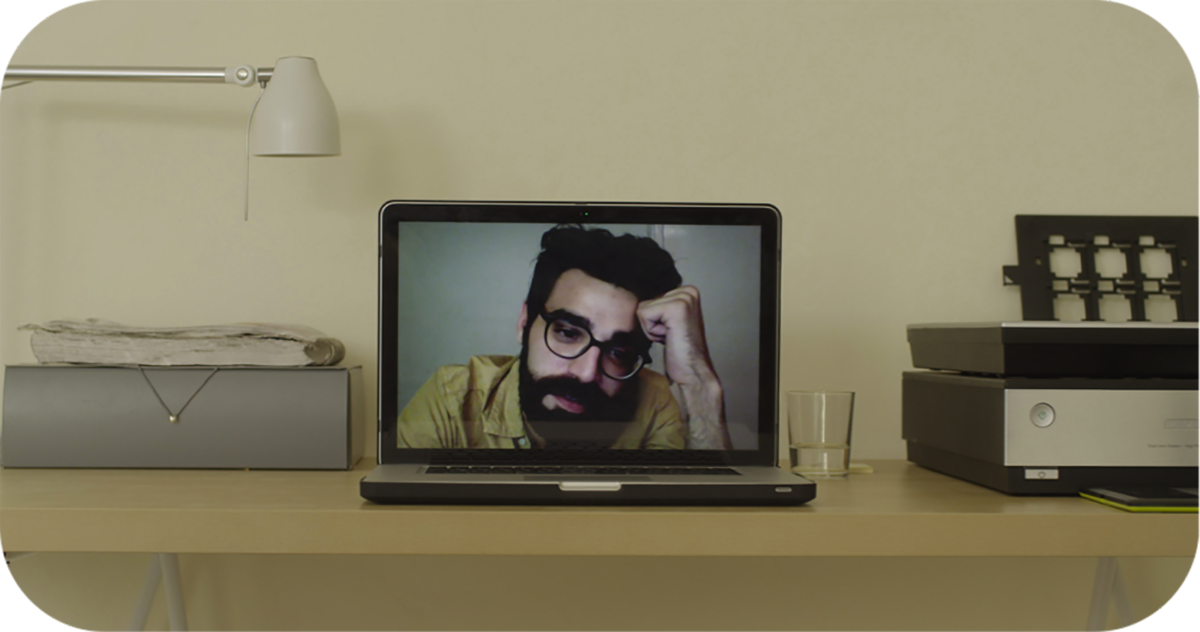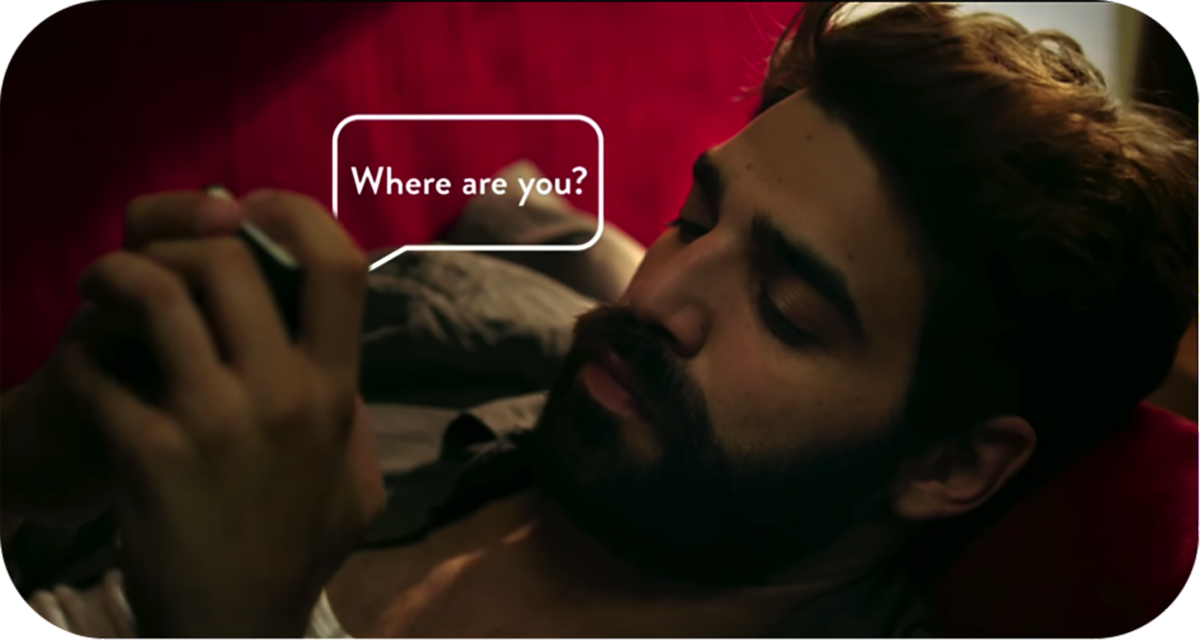From the moment I open my eyes in the morning, new media seeps into my daily routine. In bed, I punch my phone several times to ‘snooze’ my alarm clock. After the fifth time, I’ll start checking those looming notifications which lead me to my e-mails, Facebook, Instagram … When I get out of bed, I open my laptop to read some articles online while I eat my breakfast. In class, I take notes on my laptop while I’m chatting on Facebook or working on something else. We live fractured, distracted lives, constantly switching between screen and reality. When I’m watching a movie on my laptop, Facebook and e-mail notifications keep crying for my attention audibly or even in the corner of my screen.
In a time when screens are more common than ever, our cinema screens have barely changed. From its very beginning cinema has tried to capture the human experience and helped us ask questions we couldn’t express elsewhere. Yet our new media reality has been willfully ignored in cinema. Director Alex Ross Perry even made it a rule not to depict modern technology at all in his films. When directors do experiment with the incorporation of our screen reality, they get bashed. A digital screen on screen or a protagonist looking at their laptop or phone is deemed ‘uncinematic’.
The challenge directors are facing today seems simple: how to translate our new media reality to the big screen? A couple of films stand out in daring to open themselves up to the digital age. Two techniques captured my eye.
Different Solutions for the Same Problem
Skype
Several films use Skype in their narrative. In Matías Piñeiro’s Hermia & Helena (2016), the protagonist Camila talks to her friends on Skype to tell them about her stay in New York. This doesn’t add anything more to the story than if she’d told them in real life. A more refreshing take on these Skype conversations can be seen in Olivier Assayas’ Personal Shopper (2016). When Maureen is telling her boyfriend about her mission to connect with the spirit of her deceased brother, the Skype image is pixelated but still clear. As the story continues and Maureen becomes more and more confused, her boyfriend’s image is completely blurry. In this case, new media is used to convey emotion and add layers to the narrative.

Emotion transmitted through a computer screen reaches a high point in 10.000 km (2014), debut of director Carlos Marques-Marcet. This Spanish film explores the struggles of a long-distance relationship in the 21th century. Can social media be a surrogate for real-life contact? Marques-Marcet shows his protagonist couple having an intimate dinner over Skype, dancing with their laptop in their hands, or even ‘taking a walk together’ with Google Street View. Sometimes the pixelated computer screen fills up the entire frame; sometimes the laptop is shown on a desk or in the hands of the protagonists. Either way, the pixelated, colder images are a mismatch with the crystal-clear reality captured in beautiful warm colors, exemplifying their growing disconnection. When they fall asleep next to their laptops, we see their two worlds coming together on the split screen. This scene creates on the one hand the feeling of intimacy, yet at the same time a curtain-like separation of their two realities. These examples show how new media can bring value to the story you are trying to tell, just as the use of color or cinematic techniques.
Text Pop-ups
One of the most frequent techniques in cinema (and TV-series for that matter) is the use of pop-up text messages on screen. A great example is Damien Manivel’s Le Parc (2016). A teenage boy and girl have their first date at the park in some sort French teenager-edition of Before Sunrise (1995). Already in the first part of the movie, Manivel shows the omnipresent smartphone in the lives of teenagers, as when the young couple walks past a girl immersed in her screen or takes a selfie together. When the boy leaves, the girl is left alone on the grass. What would a teenager who misses a boy do when she’s left alone in the park? Get out her phone, of course. A text sequence of approximately 10 minutes ensues. As night falls and darkness surrounds her, her text messages pop-up next to her, floating on screen, only her face lit by the blue hue of the screen in front of her.
Tony Zhou of the popular YouTube-channel Every Frame a Painting highlights several reasons to use pop-up texts. Most importantly, he calls these “artistically efficient”. Whereas a shot-reverse shot sequence would first show the text message on the screen followed by the reaction of the receiver, a text pop-up allows action and reaction in the same frame. This creates a great contrast in Le Parc I most certainly recognize from my own texting. Even though the text suggests an intense emotion of anger and disbelief – “how could you say that?!!” – the girl’s face is devoid of any emotion. Her reactions to the text messages are subtle but substantial. When he tells her he already has a girlfriend, she sends him a resolute text saying “then I will not meet you” and closes her phone firmly, only to put her hands on her face in an agonized gesture. Is it lazy to convey the thoughts of your character through some sort of literal text bubble above their heads? Or does it add another layer to the narrative and emotions? I have to agree with the latter. Bringing in an outer voice of a non-present character, even if it’s just a question mark, can convey this other character’s thoughts and emotions as well while we can still focus on the character on screen.
Assayas (Personal Shopper) on the other hand uses phone close-ups during probably the longest texting sequence in film history. As personal shopper Maureen drives to the train station, skips through security, meets up with a designer in London, buys clothes, returns to the train and gets back to Paris, the camera constantly glances back to her phone. When an anonymous entity starts sending her text messages, Maureen’s imagination runs wild. Is her deceased brother texting her? Although there is no action at all I was on the edge of my seat, waiting with Maureen for her anonymous messenger to text back. Showing the phone screen was in this case the best choice. The familiar dots on the screen indicating that the other person is typing, the iPhone text message sound – for some reason every depiction of a phone has to be an iPhone – create a recognizable panic spur after sending a precarious text to someone and finally receiving the liberating response. The emotions Maureen goes through aren’t just articulated by her facial emotions in the reverse shot but also on her phone. The interesting aspect of text messages isn’t necessarily the texts which are conveying information, but the (un)timely responses, deleting the text she wanted to send, typing fast or slow … A message that has been ‘seen’, sometimes says even more than a reply.

A third aspect Zhou calls attention to is the importance of an elegant design. Director Manivel (Le Parc) uses the typical font of a text message for his text bubbles on screen. Orange text for the girl and blue for the boy. There’s no frame around the text, only a vertical line on the left or right side of the text, depending on the placing on screen. In 10 000 km, Marques-Marcet uses a big transparent text balloon with a white frame containing a matching bold white text. Both of these examples fit into the overall style of the film. The bubbly, colorful texts of Le Parc fit into a film about teenagers. In the quirky and modern story of 10 000 km, the bold white text message doesn’t feel out of place. When the text messages incorporate the aesthetic of the film in color, frame and font, they won’t feel so out of place.
Cinematic Purism and the Question of Realism
These directors try to find a solution to the discrepancy between our new media reality and their representation in cinema. Yet, not the entire public agrees with these experiments, far from it. “Cinema isn’t about reading. Don’t say it, show it” and “It kills the realism” are just a handful of typical comments. These two comments illustrate the two main arguments against the use of new media in cinema.
The first argument is as old as cinema itself. Every time a new technology wants to sneak its way onto the big screen – e.g. the first ‘talkies’, voice-overs, … – cinematic purism wants to steer cinema back to its comfort zone. Purists proclaim the primacy of the cinematic image as recorded. Anything overlaying it, such as text pop-ups or even subtitles, is degrading. Although I believe classic cinema truly is important, the thing I find most interesting about the medium is how it adapts to a new age, time and again.
The second argument involves the reality-based DNA of film. The immersive quality of cinema lets the audience sink into the narrative. Does the incorporation of Skype footage or pop-up texts on screen necessarily yank us out this illusion of realism? I would argue the opposite. In our fragmented and distracted lives, we constantly switch from online to offline, from text to video back to offline reality. In this respect, new media layers, when applied properly, shouldn’t take us ‘out’ of the film; they should even heighten a certain sense of realism. Experimenting with new media is therefore an interesting route to translating our mediated and distracted state of mind on screen.